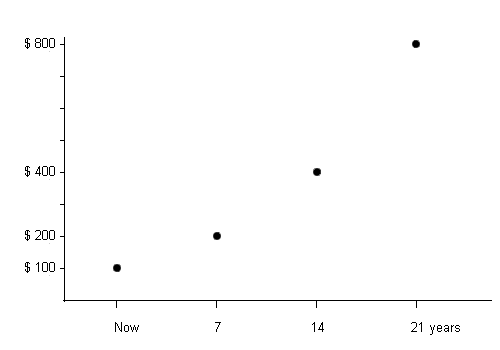Rule of 72
Have you always wanted to be able to do compound interest problems in your head?
Perhaps not... but it's a very useful skill to have because it gives you a lightning fast benchmark to determine how good (or not so good) a potential investment is likely to be.
The rule says that to find the number of years required to double your money at a given interest rate, you just divide the interest rate into 72.
For example, if you want to know how long it will take to double your money at eight percent interest, divide 8 into 72 and get 9 years.
|
Y = 72 / r and r = 72 / Y
where Y and r are the years and interest rate, respectively.
|
Compound Interest Curve
Suppose you invest $100 at a compound interest rate of 10%.
The rule of 72 tells you that your money will double every seven years, approximately:
| Years | Balance | |
| Now | $100 | |
| 7 | $200 | (doubles every |
| 14 | $400 | seven years) |
| 21 | $800 | |
If you graph these points, you start to see the familiar compound interest curve:

Practice using the Rule of 72
It's good to practice with the rule of 72 to get an intuitive feeling for the way compound interest works.
So...
Why Stop at a Double?
There's nothing sacred about doubling your money.
You can also get a simple estimate for other growth factors, as this calculator shows:
Why Does the Rule of 72 Work?
If you want to know more, see this explanation of why the rule of 72 works.
(Brace yourself, because it's slightly geeked out.)
|